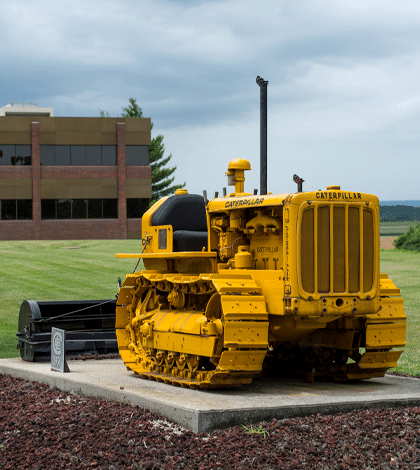Monroe County 1920-1940: the gathering storm

Luhr Brothers’ first heavy equipment, a small Caterpillar D8 bulldozer, is preserved on the front lawn of the Columbia firm, which was founded in 1939.
(Alan Dooley photo)
(This is the next monthly installment of our series looking into the 200-year history of Monroe County in honor of its Bicentennial. This article examines the years 1920 to 1940.)
The two decades from 1920 to 1940 saw changes in Monroe County, the nation and indeed the world. It was a joyous time and a troubling time. Population trends that had seen numbers drop since 1900 turned; 1920 saw 12,839 people in the county, dropping slightly to 12,754 in 1930. By 1940, there were 13,282 in Monroe County and the number never shrank again.
The 1920s have been labeled the “Roaring Twenties,” or the “Crazy Years.” The nation and world were recovering and reviving from the devastation of World War 1, and in an effort to bring back the old values, Prohibition became the law of the land when the 18th Amendment to the Constitution, passed in 1919 to prohibit manufacture, sale and transportation of “intoxicating beverages,” went into effect on Jan. 16, 1920. Andrew Volstaed’s Act codified the amendment, closing bars, saloons, and the like — at least legal ones — on that day.
But drinking didn’t stop. Many people stocked up in the year between Prohibition’s ratification and enforcement, while criminals used the opportunity to make money. Even the residents of Monroe County saw violent criminal action involving the manufacture of alcohol.
One such incident took place on Meisner Island on the Illinois side of the Mississippi River just north of Harrisonville. A well-hidden still that was producing illicit whisky was located there, along with eight distilling vats in two structures.
During the early hours of Oct. 2, 1930, rival criminals crept close to the still and the guards’ sleeping quarters and with machine guns killed two “workers” as they slept: Pete “Red” McTigue and William Boody. Two others, Sam Therina and Joe Moceri, were seriously wounded. Three others were arrested by Sheriff Joe Maul, and were subsequently charged with vagrancy and fined $100 each.
Several theories were advanced concerning who did what, to whom and why. What is recorded, though, is that one wounded man stumbled to the farm of Otto Dillenberger, who took him to a doctor in Valmeyer. Raymond Rippelmeyer, also of Valmeyer, reported almost being run off a bridge by a speeding car full of unknown men with hats pulled over their faces – probably the assassins.
While the whole incident probably brought an end to illegal liquor manufacturing in Monroe County, it also spurred a drinking binge. The still reportedly held about 80 gallons of booze at the time of the ambush. Shortly after, a number of local persons reportedly descended on the scene, and by the time Sheriff Maul moved in to confiscate evidence, only five gallons remained.
Legal drinking finally returned with enactment of the 21st Amendment on Dec. 5, 1933.
But the decades were not all excitement-filled. The 1920s saw the emergence of paved, or “hard” roads. Route 3 was paved during that time, and Route 156, from Hecker to Valmeyer, through Waterloo, was next.
Mushroom farming came to Valmeyer in 1930, when Landon Lodge of St. Louis leased space in the Columbia Quarry #3 limestone caverns, today the home of Rock City. Known as Valmeyer Farms, the mushroom growing facility flourished until the 1940s, when it was sold to the Knaust family. It operated as a mushroom farm until the 1980s. Today, the tunnels offer ultra-safe storage for various products and secure a large percentage of the holdings of the National Personnel Records Center’s military and civilian records.
The Roaring Twenties, with flapper girls, illegal saloons and other excitement, didn’t end with the stock market crash on Black Tuesday, Oct. 29, 1929. But that was certainly a turning point. By 1933, nationwide unemployment reached 30 percent and about half of the nation’s banks collapsed in what we know today as the Great Depression.
But there is some good that remains from the political, social and economic disaster of the Depression. One event that still provides summer joy to county citizens on Tuesday summer nights in Waterloo is the Waterloo Municipal Band, which was established in 1931. Also, a new newspaper emerged in Columbia in 1939 – the Monroe County Clarion, established by Guy Haltenhof.
And one of the iconic businesses of the region, Luhr Brothers, came on the scene in 1939. Brothers Eugene and Alois started together, with Eugene taking out a loan to buy their first construction machine, a Caterpillar D8 dozer, which Alois put to work excavating the footings for the new Valmeyer High School.
Today, Luhr Brothers is the nation’s pre-eminent navigation marine contractor, dominating navigation structure work in the Mississippi River, other tributary inland waterways and into the Gulf of Mexico.
The end of the decade of the 1930s was a time of growing tension. World War II was underway in Europe, with Germany invading Poland and threatening the rest of Europe. And for the large number of German descendents in the area, it was a time of growing concern.
As during World War I, many non-Germans once again viewed their German neighbors with distrust, and German descendents feared retaliation for their ancestry.
One example of the tensions then, according to Monroe County clerk, local historian and Monroe County Bicentennial co-chair Dennis Knobloch, was experienced at the church in Maeystown, where services were still conducted in German. Unknown persons threatened parishioners for this and the churchgoers deemed it prudent to post lookouts during services to sound a warning if an attack seemed eminent. Mercifully, cooler heads prevailed and no such event occurred.
Controversy, not unlike the political dialog dominating media today, reigned, as those who wanted to enter the war argued with those who wanted to remain isolated – sometimes loudly and violently.
A year into the next decade, that decision would be made for America, unifying us all again. But that’s a story for the next edition of remembering Monroe County’s first two centuries.






